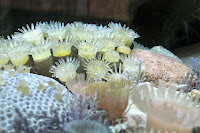A trip
through Iowa Hall is very much a trip through Iowa’s past – step in the
galleries and you’ll see Iowa before it became farmland, before highways and
roads began to criss-cross the state, before Iowa City was even a city at
all.
After
many, many trips through Iowa Hall myself, I’ve decided that some exhibits in
the gallery are easier to fathom than others.
We know of the Native Americans who used to live on the land, before
settlers came; we can even believe that Rusty, tall and large as he is, used to
live in an Iowa covered by glaciers.
(After all, sometimes the winter feels
like the Ice Age.) But it’s harder to believe that Iowa was once a tropical
swampland, and that it was once underwater, harder still.
The
Devonian exhibit is the first in Iowa Hall, and it’s a true glimpse into an
Iowa that’s long gone: Iowa from 360 million years ago, covered in shallow,
sunny waters, filled with ancient cephalopods and armored fish? It’s true.
 The
armored fish in question would be Dunky – short for Dunkleosteus – a
prehistoric fish who used to rule the seas. We think sharks today are scary,
but a shark would have paled in comparison to Dunky (there is a shark in the Devonian exhibit, but it’s far smaller), who as
an adult would have been two stories tall and the length of a school bus. He could open his jaw as wide as it would go,
and it would create so much pressure that anything in the vicinity would have
been sucked in – this even included other fish.
The
armored fish in question would be Dunky – short for Dunkleosteus – a
prehistoric fish who used to rule the seas. We think sharks today are scary,
but a shark would have paled in comparison to Dunky (there is a shark in the Devonian exhibit, but it’s far smaller), who as
an adult would have been two stories tall and the length of a school bus. He could open his jaw as wide as it would go,
and it would create so much pressure that anything in the vicinity would have
been sucked in – this even included other fish.
 Trilobites,
the first animals to develop eyes, were around in this period, too – although
they went extinct at the end of the Devonian, the exhibit is home to many – as
are ammonites, which also went extinct.
Ammonites, which look similar to cephalopods, had huge, hollow shells,
and the ammonite could slide its body in and out, controlling its buoyancy and
position in the water. If it’s hard to
believe these animals really existed, it’s harder to believe they once lived in
Iowa, a place very much out of water
– but the fossils never lie.
Trilobites,
the first animals to develop eyes, were around in this period, too – although
they went extinct at the end of the Devonian, the exhibit is home to many – as
are ammonites, which also went extinct.
Ammonites, which look similar to cephalopods, had huge, hollow shells,
and the ammonite could slide its body in and out, controlling its buoyancy and
position in the water. If it’s hard to
believe these animals really existed, it’s harder to believe they once lived in
Iowa, a place very much out of water
– but the fossils never lie.
Dunky
and the trilobites aren’t the only things in the exhibit – there are plenty of
animals that today you might find on coasts or coral reefs. Huge expanses of
coral, like what today you might find in Australia, cover the exhibit, as they
would have covered the ocean floor (coral, interestingly enough, is actually an
animal). My favorite, however, would
have to be the crinoids, or sea lilies.
They look like underwater flowers, but are actually delicate animals
that use the ocean currents to catch small, microscopic organisms to eat.
But it’s
this varied, sometimes unbelievable history that makes Iowa’s past interesting
– it’s the idea that Iowa hasn’t always been farmland and rolling hills, but
instead a glacial paradise, a quasi-rainforest, or a shallow sea. And that’s why, even after countless trips,
Iowa Hall is still a fascinating place – we’ll never get to see Iowa as
anything but prairie and farmland, but step through Iowa Hall and you’ll get
amazingly close.
-Written by MNH Volunteer Catherine Babikian

They started declining in the Devonian, but trilobites hung on until the end of the Permian.
ReplyDelete